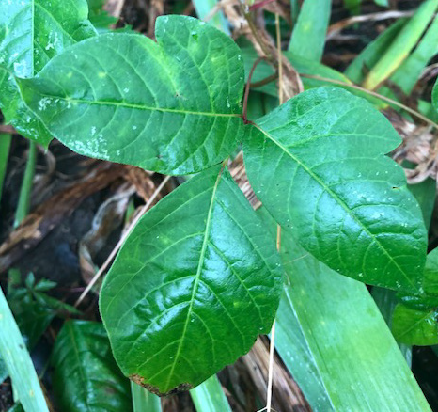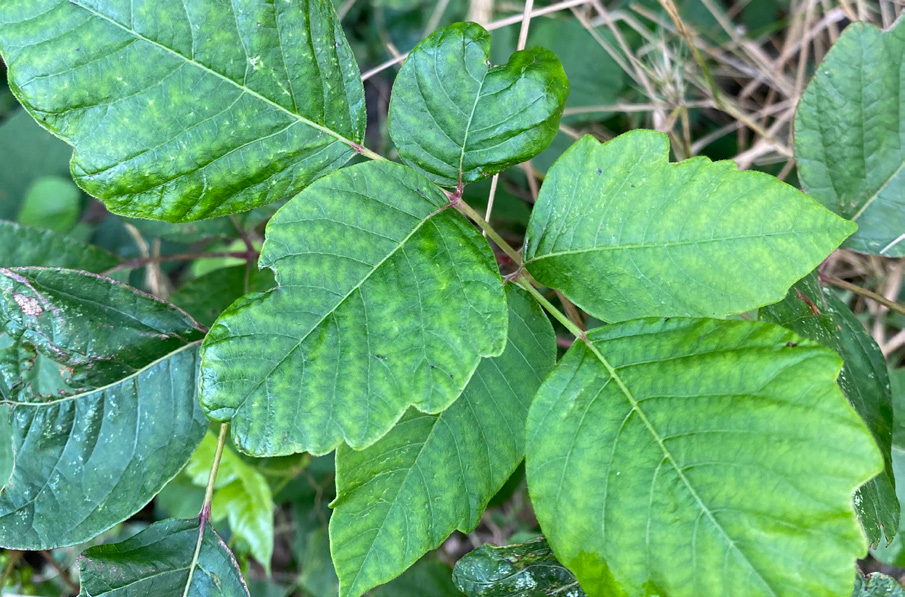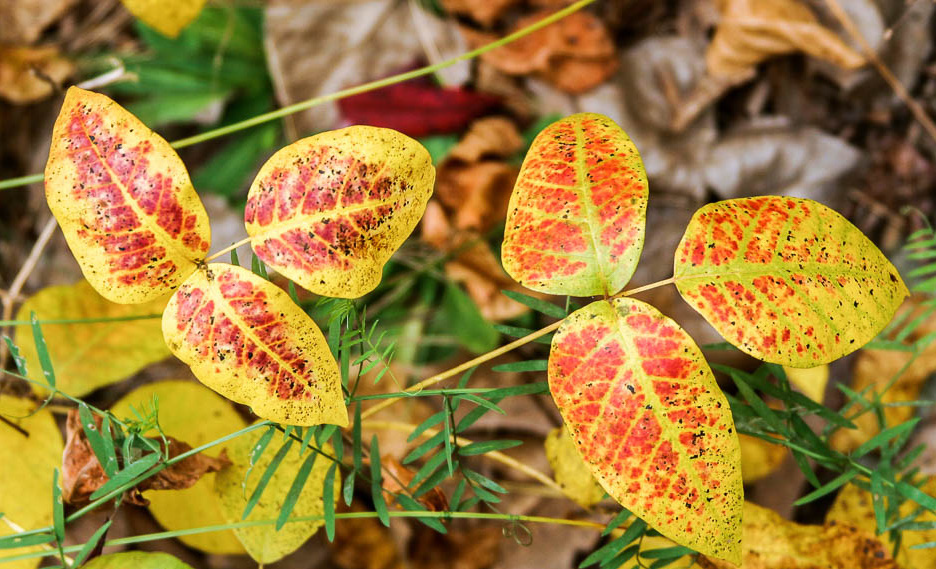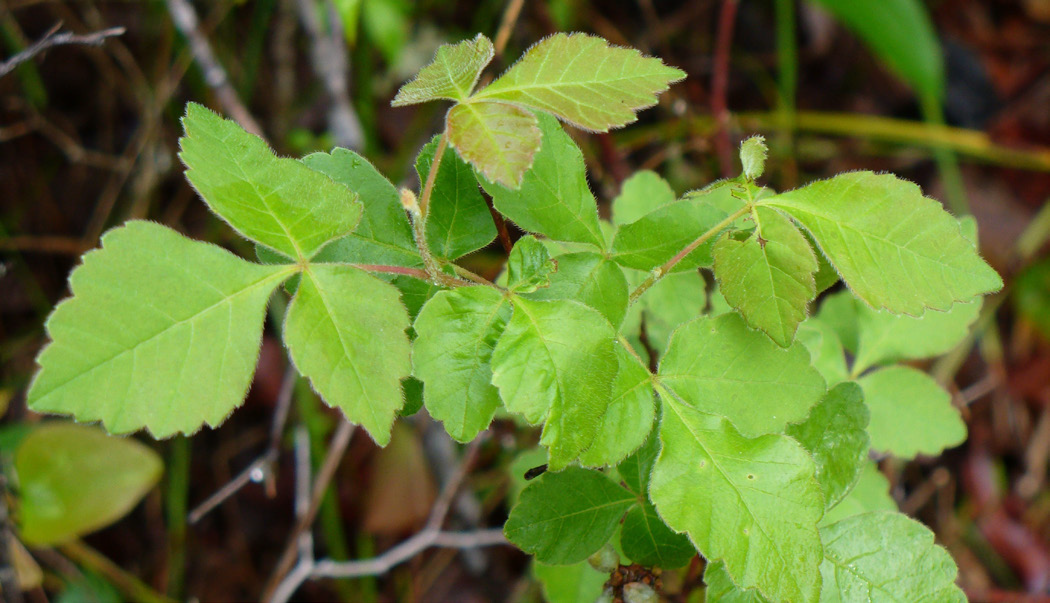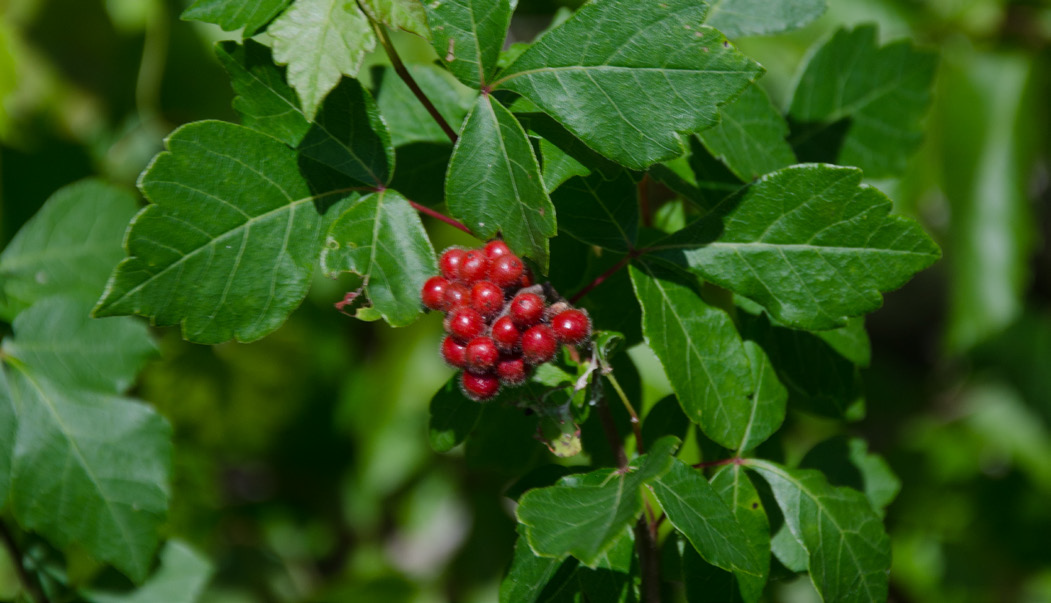Poison Ivy, Poison Oak and Similar Plant Identification
- Jump To:
- References
“Leaves of three, let it be” – That rhyme makes many people think that identifying poison ivy is simple, but that isn’t always the case. Knowing how to recognize poison ivy, oak and sumac can save you from a miserable red, itchy rash. These three closely related plants contain an irritating oily sap called urushiol, which causes many people to break out in a rash when it comes in contact with their skin. Being able to identify these plants is beneficial, considering there are many plants that look similar but are harmless. This fact sheet will educate the general public on how to identify poison ivy, poison oak and poison sumac so they can be avoided.
Poison ivy is located across the lower 48 states and can grow in a variety of conditions, although it is most abundant along forest edges and in open forests with moderate sunlight. Poison oak is most common in the west and east and not as common in the central United States. Poison sumac does not occur in Oklahoma and is mainly found in the eastern and southeastern parts of the U.S., because it prefers to grow in wet forested areas. In Oklahoma, poison ivy exists across most of the state but is less abundant in the southwest and panhandle areas of the state. Poison oak occurs in scattered locations across Oklahoma and is far less abundant than poison ivy.
Poison ivy leaves are compound and consists of three individual leaflets (Figure 1). The plants leaves can vary from smooth to being lobed (looks like a pair of mittens) or toothed (pointed). Poison oak leaves are usually in clusters of three leaflets and are lobed or deeply toothed with rounder edges (Figure 2). Just as leaf shape varies, so do the colors of leaves on each plant. Poison ivy leaves start out shiny in the spring and become a dull green during the summer. In the autumn, they turn yellow or scarlet (Figure 3). Poison oak is green throughout the spring and summer, and its leaves become more yellow with brown undertones in autumn (Figure 4).
Figure 1. Poison ivy in the summer. This poison ivy has lobed edge leaves. (Photo courtesy of Pam Sharp)
Figure 2. Poison oak in the spring/summer. This poison oak has lobed edge leaves. (Photo courtesy of Bailey Lockhart)
Figure 3. Poison ivy in the autumn. This poison ivy has smooth edge leaves. (Photo courtesy of poison-ivy.org)
Figure 4. Poison Oak in the autumn. This poison oak has lobed edge leaves. (Photo credit Linda Tanner, Flickr)
There are many common look-a-like plants that people confuse with poison ivy and poison oak. The common ones in Oklahoma are Virginia creeper, fragrant sumac, skunk bush sumac and boxelder. Virginia creeper leaves are compound and contain five leaflets (Figure 5). Each leaflet has toothed (pointed) edges. Virginia creeper are red when they first emerge but then turn green as they mature. During the autumn, they turn back to red or maroon color. Virginia creeper looks like it is giving you a high five, so it is easier to identify among similar looking plants. It can cause a mild rash in some individuals, but it is nothing like the rash that poison ivy/oak causes.
Figure 5. Virginia creeper. This Virginia creeper has toothed edge leaves. (Photo courtesy of Randy Evans)
Fragrant sumac has trifoliate toothed leaves that are a green blue shade (Figure 6). During the autumn, the leaves’ color change to shades of red and purple. Fragrant sumac, unlike poison oak, produces red berries (Figure 7). This is a good identifying clue to look for. Sumac also tends to form dense compact mottes (grove of trees) rather than having the more open structure of poison oak.
Figure 6. Fragrant Sumac. This fragrant sumac has toothed edge leaves. Photo courtesy of Jeff McMillian @ Almost Eden, hosted by the USDA-NRCS PLANTS Database.
Figure 7. Fragrant Sumac with berries. This fragrant sumac has toothed edge leaves. (Photo courtesy of Suzanne Cadwell, Flickr)
Skunk bush sumac leaves are compound, and the leaflets grow in groups of three and are waxy and soft-textured (Figure 8). The leaves are green during the summer and spring then turn a bright red or orange during the autumn. To distinguish skunk bush sumac from poison oak, it grows red, hairy berries, while poison oak has whitish or yellowish berries.
Figure 8. Skunkbush Sumac. This skunkbush sumac has lobed edge leaves. (Photo courtesy of Patrick J. Alexander, hosted by the USDA-NRCS PLANTS Database)
Boxelder leaves are compound and consist of three to five toothed leaflets (Figure 9). Leaves are the standard common leaf that grows on a branch or a stem while leaflets refer to a small leaf or a leaf-like part of a compound leaf. It completely resembles a leaf but is in fact, a segment of what makes up the compound leaf. Unlike a leaf, a leaflet is not attached to the main plant stem or branch; it is attached to the branch of the leaf. The leaves are in pairs that are opposite and are light green in the summer with little color variation in the fall. Young boxelder can be mistaken for poison ivy, but the difference between the two is that boxelder leaves are opposite, while poison ivy leaves are alternating. As boxelder grows into a large tree, it is easily distinguished once it is mature.
Figure 9. This boxelder has toothed edge leaves. (Photo courtesy of Randy Evans)
There are several different methods to control poison ivy, oak and sumac. Mechanical methods, such as a lawnmower or weed eater, can remove the above ground portion of the plant, but this is not a permanent solution as it will resprout from the root. Keep in mind, the proper attire that should be worn with potential exposure to the urushiol oil. This includes eye protection, gloves, pants and long sleeves. For smaller gardens or flower beds, hand pulling works, but it is best done when the seedling is still small. Be sure to wear gloves to keep the oils off your skin and note that even the stems and roots contain the oils. Poison ivy can mature into trees, and the stem can be cut at ground level with a hatchet or saw. Herbicides are an effective way to permanently kill poison ivy or oak. Following herbicide directions precisely is critical to ensure the safety of yourself and other plants surrounding the poison ivy. Hiring a professional can give you peace of mind and is always an option if you do not feel comfortable handling the herbicides yourself. Several herbicides are effective to kill poison ivy/oak. Glyphosate and triclopyr are two of the more common effective herbicides. They can both be applied as foliar applications to active growing plants, or the cut stem can be treated anytime during the year except early spring during sap flow. Prescribed fire performed correctly on a three- to five-year burn interval is another effective way to mitigate and kill poison ivy or oak.
If you come in contact with any poison ivy/oak, steps can be taken to help control
or even prevent the spreading of the developing rash. Always consult a physician first
and follow their professional advice. Immediately wash the skin where urushiol oil
is suspected. Use rubbing alcohol, dishwashing liquid or a special soap made for use
after contact with poison ivy or oak. Do not scrub the area when washing, because
that can cause the oil to spread further onto more skin. Rinse thoroughly with cool
water. The itchy rash can be relieved by using topical lotions and creams, such as
hydrocortisone or calamine lotions, and cool compresses can help to reduce itching
and inflammation. These are just some of the home remedies that can help relieve the
itch.
References
- Brown, Diane. “Identifying poison ivy isn’t always easy to do.” Fact Sheet. Michigan State University. East Lansing, MI, 26 July. 2016. Web. 5 Jun. 2020.
- “Eastern Poison Ivy (Toxicodendron Radicans).”
- “Home Grown Facts.” Fact Sheet. Cornell Cooperative Extension of Oneida County. Oriskany, NY. n.d. Web. 10 June 2020.
- Beaulieu, David. “Poison Ivy Plant Profile, Toxicity and Special Consideration.” Fact Sheet. 30 Jan. 2020. Web.
- Lerner, B. Rosie. Legleiter. Travis. “Poison Ivy.” HO-218-W. Consumer Horticulture, Purdue Extension. Oct. 2015. Web. 18 June 2020.
- Otte, Chuck (2020, June 21). “Poison Ivy: An Identification and Control Guide.” Kansas State University.
The authors thank Dr. Dwayne Elmore for his input and review of this document.

